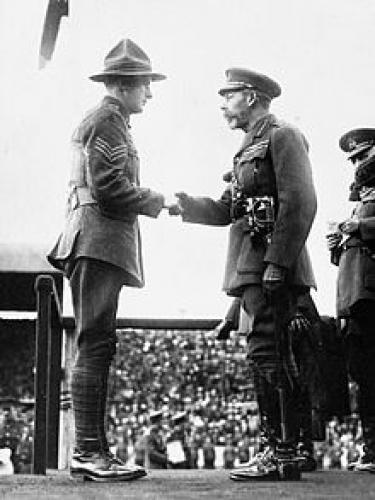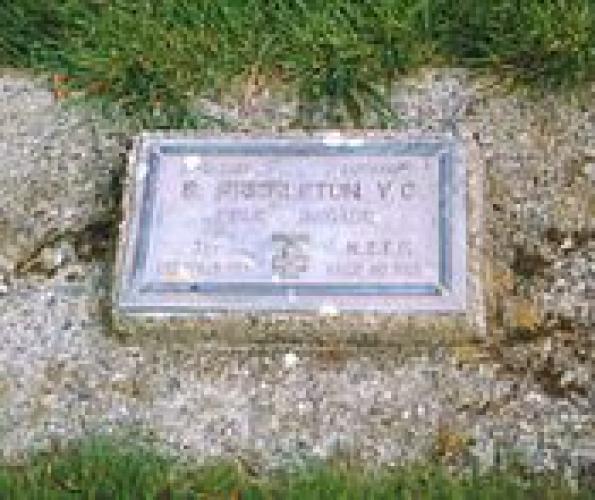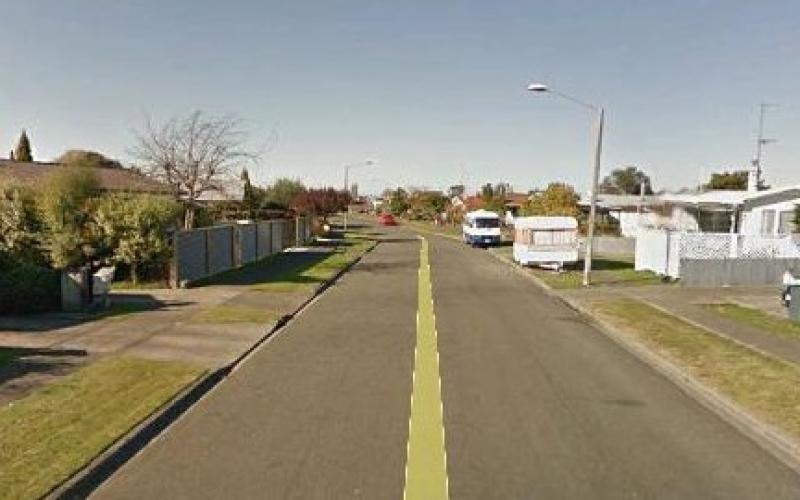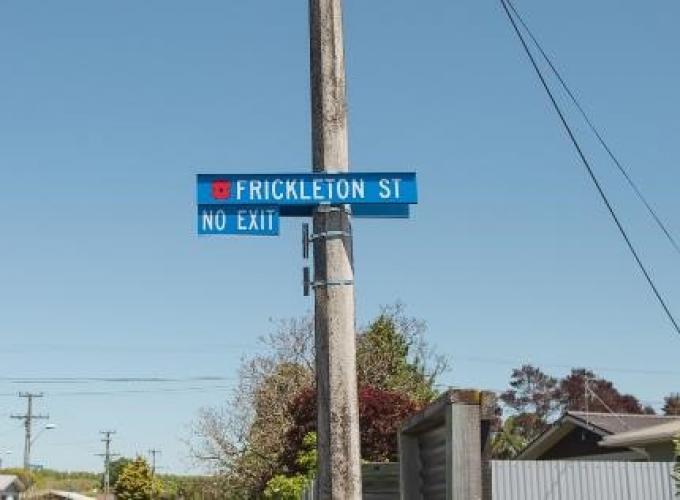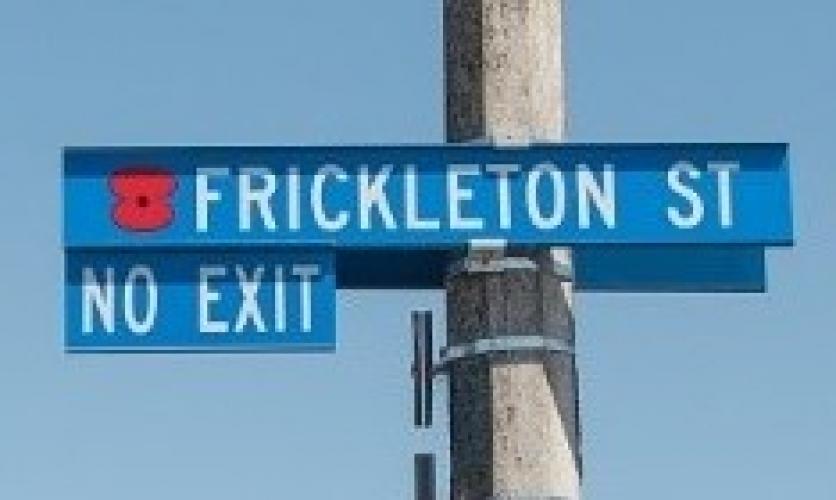069 Frickleton Street Napier, street scene 2017
Reason for the name
This Napier street was named in honour of Lance Corporal Samuel Frickleton who took part in the attack on Messines, Belgium, on 7 June 1917. When his unit was pinned down by heavy machine-gun fire, he single handedly attacked two machine-gun posts, killing their crews. He was wounded in the hip and later gassed. For these acts of extreme gallantry, he was awarded the Victoria Cross. Immediately promoted to sergeant, Samuel was later sent to an Officer Cadet Training Unit in Cambridge. He graduated as a 2nd lieutenant in March 1918.
Samuel Frickleton, VC, ED (1 April 1891 – 6 August 1971) was a soldier in the New Zealand Military Forces and recipient of the Victoria Cross (VC), the highest award of the British Commonwealth for gallantry in "the face of the enemy". He was awarded the VC for his actions in the Battle of Messines during the First World War.
Author: Poppy Places Trust
Samuel Frickleton, VC, ED (1 April 1891 – 6 August 1971) was a soldier in the New Zealand Military Forces and recipient of the Victoria Cross (VC), the highest award of the British Commonwealth for gallantry in "the face of the enemy". He was awarded the VC for his actions in the Battle of Messines during the First World War.
Born in 1891 in Scotland, Frickleton was a miner when he enlisted with the New Zealand Expeditionary Force (NZEF) the year after the outbreak of the First World War. He took ill on reaching the Middle East and had to be repatriated to New Zealand. Although he had been discharged from the NZEF, he re-joined after recovering his health. He was posted to the 3rd Battalion, New Zealand Rifle Brigade, then serving on the Western Front. Wounded during the Battle of Messines, he received medical treatment in England after which he underwent officer training. However, his health was still poor and before the end of the war was returned to New Zealand. He later served in the New Zealand Staff Corps. He went to London in 1937 for the coronation of King George VI and Queen Elizabeth and again nearly 20 years later for the VC centenary. He also served on the home front during the Second World War. He died in 1971 at the age of 80.
Early Life
Frickleton was born on 1 April 1891 in Slamannan in Scotland, one of 11 children born to Samuel Frickleton, a coal-miner, and his wife Elizabeth. Following the death of his father, he immigrated to New Zealand in 1913, with his mother and the rest of her children. The family lived on the West Coast. He and his four brothers worked in a coal mine in Blackball.
Military Career
Following the outbreak of the First World War, Frickleton joined the New Zealand Military Forces in February 1915 and volunteered to serve overseas with the New Zealand Expeditionary Force (NZEF). His four brothers had also volunteered for the NZEF.
Frickleton embarked for the Middle East with the 5th Reinforcements with the rank of corporal in the Canterbury Battalion. After arriving in Egypt in June, he became ill, was repatriated to New Zealand and subsequently discharged as medically unfit for active service. After a period of convalescence, he re-enlisted for the NZEF in 1916. Later that year, he was posted to France as a rifleman in the 3rd Battalion, New Zealand Rifle Brigade. By March 1917, he had been promoted to corporal.
On 7 June 1917, Frickleton participated in the Battle of Messines. His battalion was attacking the edge of Messines village when it was slowed by two machine gun posts. He was awarded a Victoria Cross (VC) for his actions in dealing with these posts. The VC, instituted in 1856, was the highest gallantry award that could be bestowed on a soldier of the British Empire. The citation for his VC read as follows:
For most conspicuous bravery and determination when with attacking troops, which came under heavy fire and were checked. Although slightly wounded, Lance Corporal Frickleton dashed forward at the head of his section, rushed through a barrage and personally destroyed with bombs an enemy machine gun and crew, which were causing heavy casualties. He then attacked the second gun, killing the whole of the crew of twelve. By the destruction of these two guns he undoubtedly saved his own and other units from very severe casualties and his magnificent courage and gallantry ensured the capture of the objective. During the consolidation of the position he suffered a second severe wound. He set, throughout, a great example of heroism.
— London Gazette, No. 30215, 2 August 1917.
Frickleton was wounded in the arm and hip and also was badly gassed; his injuries affected his health for the remainder of his life. Evacuated to England for medical treatment, he was presented with his VC by King George V on 17 September 1917, in a ceremony at Glasgow. By then he was an acting sergeant, which was confirmed later that year. After a period of further hospitalisation, he was selected for and underwent officer training. He was commissioned as a second lieutenant in March 1918 and returned to the Rifle Brigade. However, his health problems persisted and he again was repatriated to New Zealand in June 1918.
The first of the VC recipients of the NZEF to return to New Zealand, Frickleton was accorded a hero's welcome. A reception was held in Frickleton's honour at the Auckland Town Hall. He spent the remainder of the year under medical care. He was discharged from the NZEF in December 1918. Of his brothers who also served in the war, one was killed in the Battle of the Somme, and three others were wounded.
Later Life and Legacy
After the war, Frickleton transferred to the New Zealand Staff Corps. He was promoted to acting Lieutenant and served as assistant Provost Marshall for the Wellington Military District for several months until June 1919. He was then transferred to the Canterbury Military District. For health reasons, he retired from the military with the rank of captain in April 1927.
In civilian life he tried several professions. At first, he took up business in Wellington and then tried farming at Waikanae. He later worked as a house manager. His poor health notwithstanding, in 1934 he joined the Territorial Force with the rank of captain. He was later awarded the Efficiency Decoration for his long service in the military. He was part of the New Zealand contingent sent to London in 1937 for the coronation of King George VI and Queen Elizabeth. He was returned to the Officer Reserve the same year. In 1939, Frickleton was recalled to active duty and served as Inspector, New Zealand Military Forces. He was returned to the Retired List in 1948. In 1956, he was one of 400 VC winners who paraded in Hyde Park in London.
Frickleton died in 1971 in Wellington after a long illness. He was survived by his wife, whom he married in 1922, and a son. He is buried in the Taita Serviceman's Cemetery, Naenae. There are several memorials to his memory; on 7 June 2007, a plaque commemorating his bravery was unveiled at the Mesen Church in Belgium in a ceremony attended by two of his granddaughters. There is also a plaque in his honour at the Messines Ridge British Cemetery.
Medal
In 1977, Frickleton's wife donated his VC and other medals to the QEII Army Memorial Museum in Waiouru. The VC was on display when it was one of nine Victoria Crosses that were among a hundred medals stolen from the museum in December 2007. On 16 February 2008, New Zealand Police announced all the medals had been recovered as a result of a NZ$300,000 reward offered by Michael Ashcroft and Tom Sturgess.

